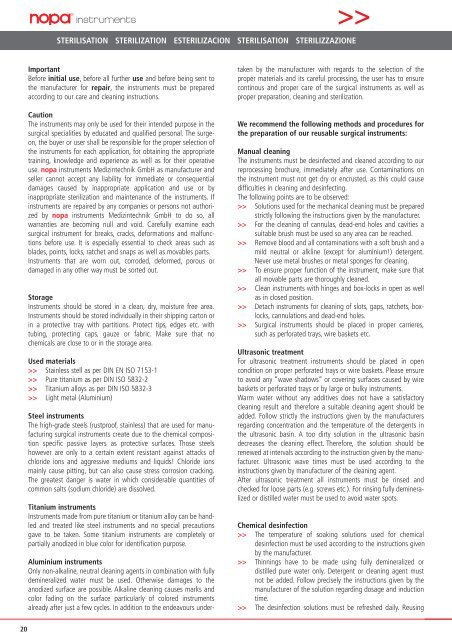Download - nopa instruments
Download - nopa instruments
Download - nopa instruments
Sie wollen auch ein ePaper? Erhöhen Sie die Reichweite Ihrer Titel.
YUMPU macht aus Druck-PDFs automatisch weboptimierte ePaper, die Google liebt.
STERILISATION STERILIZATION ESTERILIZACION STERILISATION STERILIZZAZIONE<br />
Important<br />
Before initial use, before all further use and before being sent to<br />
the manufacturer for repair, the <strong>instruments</strong> must be prepared<br />
according to our care and cleaning instructions.<br />
Caution<br />
The <strong>instruments</strong> may only be used for their intended purpose in the<br />
surgical specialities by educated and qualified personal. The surgeon,<br />
the buyer or user shall be responsible for the proper selection of<br />
the <strong>instruments</strong> for each application, for obtaining the appropriate<br />
training, knowledge and experience as well as for their operative<br />
use. <strong>nopa</strong> <strong>instruments</strong> Medizintechnik GmbH as manufacturer and<br />
seller cannot accept any liability for immediate or consequential<br />
damages caused by inappropriate application and use or by<br />
inappropriate sterilization and maintenance of the <strong>instruments</strong>. If<br />
<strong>instruments</strong> are repaired by any companies or persons not authorized<br />
by <strong>nopa</strong> <strong>instruments</strong> Medizintechnik GmbH to do so, all<br />
warranties are becoming null and void. Carefully examine each<br />
surgical instrument for breaks, cracks, deformations and malfunctions<br />
before use. It is especially essential to check areas such as<br />
blades, points, locks, ratchet and snaps as well as movables parts.<br />
Instruments that are worn out, corroded, deformed, porous or<br />
damaged in any other way must be sorted out.<br />
Storage<br />
Instruments should be stored in a clean, dry, moisture free area.<br />
Instruments should be stored individually in their shipping carton or<br />
in a protective tray with partitions. Protect tips, edges etc. with<br />
tubing, protecting caps, gauze or fabric. Make sure that no<br />
chemicals are close to or in the storage area.<br />
Used materials<br />
>> Stainless stell as per DIN EN ISO 7153-1<br />
>> Pure titanium as per DIN ISO 5832-2<br />
>> Titanium alloys as per DIN ISO 5832-3<br />
>> Light metal (Aluminium)<br />
Steel <strong>instruments</strong><br />
The high-grade steels (rustproof, stainless) that are used for manufacturing<br />
surgical <strong>instruments</strong> create due to the chemical composition<br />
specific passive layers as protective surfaces. Those steels<br />
however are only to a certain extent resistant against attacks of<br />
chloride ions and aggressive mediums and liquids! Chloride ions<br />
mainly cause pitting, but can also cause stress corrosion cracking.<br />
The greatest danger is water in which considerable quantities of<br />
common salts (sodium chloride) are dissolved.<br />
Titanium <strong>instruments</strong><br />
Instruments made from pure titanium or titanium alloy can be handled<br />
and treated like steel <strong>instruments</strong> and no special precautions<br />
gave to be taken. Some titanium <strong>instruments</strong> are completely or<br />
partially anodized in blue color for identification purpose.<br />
Aluminium <strong>instruments</strong><br />
Only non-alkaline, neutral cleaning agents in combination with fully<br />
demineralized water must be used. Otherwise damages to the<br />
anodized surface are possible. Alkaline cleaning causes marks and<br />
color fading on the surface particularly of colored <strong>instruments</strong><br />
already after just a few cycles. In addition to the endeavours under-<br />
taken by the manufacturer with regards to the selection of the<br />
proper materials and its careful processing, the user has to ensure<br />
continous and proper care of the surgical <strong>instruments</strong> as well as<br />
proper preparation, cleaning and sterilization.<br />
We recommend the following methods and procedures for<br />
the preparation of our reusable surgical <strong>instruments</strong>:<br />
Manual cleaning<br />
The <strong>instruments</strong> must be desinfected and cleaned according to our<br />
reprocessing brochure, immediately after use. Contaminations on<br />
the instrument must not get dry or encrusted, as this could cause<br />
difficulties in cleaning and desinfecting.<br />
The following points are to be observed:<br />
>> Solutions used for the mechanical cleaning must be prepared<br />
strictly following the instructions given by the manufacturer.<br />
>> For the cleaning of cannulas, dead-end holes and cavities a<br />
suitable brush must be used so any area can be reached.<br />
>> Remove blood and all contaminations with a soft brush and a<br />
mild neutral or alkline (except for aluminium!) detergent.<br />
Never use metal brushes or metal sponges for cleaning.<br />
>> To ensure proper function of the instrument, make sure that<br />
all movable parts are thoroughly cleaned.<br />
>> Clean <strong>instruments</strong> with hinges and box-locks in open as well<br />
as in closed position.<br />
>> Detach <strong>instruments</strong> for cleaning of slots, gaps, ratchets, boxlocks,<br />
cannulations and dead-end holes.<br />
>> Surgical <strong>instruments</strong> should be placed in proper carrieres,<br />
such as perforated trays, wire baskets etc.<br />
Ultrasonic treatment<br />
For ultrasonic treatment <strong>instruments</strong> should be placed in open<br />
condition on proper perforated trays or wire baskets. Please ensure<br />
to avoid any “wave shadows” or covering surfaces caused by wire<br />
baskets or perforated trays or by large or bulky <strong>instruments</strong>.<br />
Warm water without any additives does not have a satisfactory<br />
cleaning result and therefore a suitable cleaning agent should be<br />
added. Follow strictly the instructions given by the manufacturers<br />
regarding concentration and the temperature of the detergents in<br />
the ultrasonic basin. A too dirty solution in the ultrasonic basin<br />
decreases the cleaning effect. Therefore, the solution should be<br />
renewed at intervals according to the instruction given by the manufacturer.<br />
Ultrasonic wave times must be used according to the<br />
instructions given by manufacturer of the cleaning agent.<br />
After ultrasonic treatment all <strong>instruments</strong> must be rinsed and<br />
checked for loose parts (e.g. screws etc.). For rinsing fully demineralized<br />
or distilled water must be used to avoid water spots.<br />
Chemical desinfection<br />
>> The temperature of soaking solutions used for chemical<br />
desinfection must be used according to the instructions given<br />
by the manufacturer.<br />
>> Thinnings have to be made using fully demineralized or<br />
distilled pure water only. Detergent or cleaning agent must<br />
not be added. Follow precisely the instructions given by the<br />
manufacturer of the solution regarding dosage and induction<br />
time.<br />
>> The desinfection solutions must be refreshed daily. Reusing<br />
20



